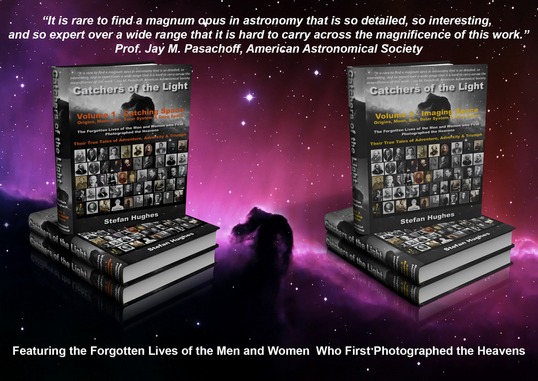'The 'c' Men'

Armand Hippolyte Fizeau
Born: 23rd September 1819, Paris, France
Died: 18th September 1896, Ferte-sous-Jouarre, Seine-et-Marne, France
Jean Bernhard Leon Foucault
Born 18th September 1819, Paris, France
Died 11th February 1868, Paris, France
Armand Hippolyte Fizeau and Jean Bernhard Leon Foucault were two of the greatest physicists of the nineteenth century. Their improvements to the photographic process and the development of terrestrial methods for the determination of a more accurate value for the speed of light, paved the wave for many advances in all branches of science. Together they obtained the first successful images of the Sun’s surface showing clearly the presence of sunspots.
Although it was to America that the spoils of victory went in the race to take the first successful astronomical photograph, it was to France and Louis Jacques Mande Daguerre (1787-1851), that John William Draper (1811-1882) owed the technical means by which he obtained his famous 1840 image of the Moon. It was also to France that we owe the next major advance in Astrophotography, and the Solar Photography of Armand Hippolyte Louis Fizeau (1819-1896) and Jean Bernhard Leon Foucault (1819-1868).
The Moon and the Sun are by far the two brightest objects in the sky, with Sunlight dominating the daylight hours and Moonlight ruling over the hours of darkness. As John W. Draper had captured the image of the Moon, it was only natural that the Sun should be the next focus of attention in the new field of celestial photography. So it was to the Sun that Fizeau and Foucault applied their combined photographic expertise during the period 1843 to 1845.
According to the then Director of the Paris Observatory, Francois Jean Dominique Arago (1786-1853), the two Physicists took during this period a series of Daguerreotype images of the Sun, which were the first to successfully capture the face of our star. Fortunately, one of these images has survived, dated the 2nd of April 1845 and shows clearly the presence of sunspots on its surface; and as such is one of the most important astronomical photographs ever taken.
Today the names of Fizeau and Foucault are not known for their photographic achievements, but as two of the greatest physicists of the nineteenth century. In particular, they were the first scientists to measure the speed of light by terrestrially based measurements and not through astronomical observation. Although they began working together at Arago’s suggestion in 1845, they parted company after a few years and began to work independently of each other.
In 1849 Fizeau obtain a value for the speed of light ‘c’, of 195,615 miles (315,000 km) per second - a number slightly higher (by about five percent) than that obtained by astronomical means, but certainly far more accurate than any previous terrestrial method had yielded. The modern figure for the speed of light is approximately 186,000 miles (299,700 km) per second.
A year later in the April of 1850 his former partner, Foucault had developed his own means of measurement and showed that light travels slower in water than in air. This was in accordance with what the wave theory of light predicted, but contradicted the predictions of Newton’s corpuscular theory. Foucault is also better known today for his ‘Pendulum’ experiment which demonstrated the daily rotation of the Earth on its axis; and as a telescope maker of some note.
The lives and careers of Fizeau and Foucault are so entwined that it is impossible to tell the story of one without telling that of the other. After all, they were born within five days of each other in Paris; they attended the same school; they both had intended to follow a career in medicine; they were experts in the use of the newly invented Daguerreotype photographic process; and they also worked together at the Paris Observatory.
They were for many years like twin brothers, until they fell out over the matter of ‘c’, but not before they had written themselves into history as two of the great pioneers of Astrophotography.
To read more on their life and work read the eBook chapter on Hippolyte Fizeau & Leon Foucault or buy the Book 'Catchers of the Light'.

The Sun, 2nd of April 1845, Hippolyte Fizeau & Leon Foucault, Paris Observatory

Buy the eBook or Printed Book at the 'Catchers of the Light' shop.